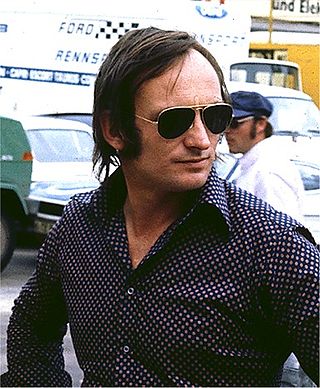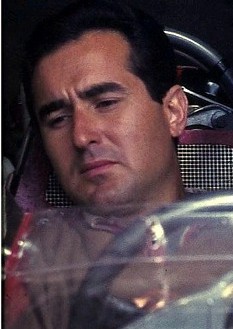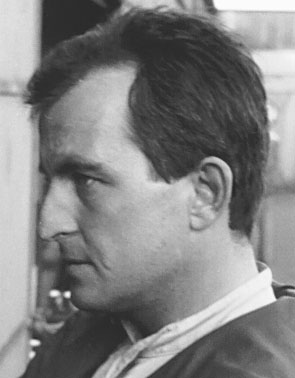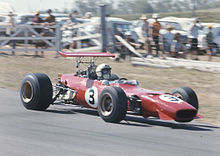Scuderia Ferrari currently competing as Scuderia Ferrari HP, is the racing division of luxury Italian auto manufacturer Ferrari and the racing team that competes in Formula One racing. The team is also known by the nickname "The Prancing Horse", in reference to their logo. It is the oldest surviving and most successful Formula One team, having competed in every world championship since 1950.

John Norman Surtees, was a British racing driver and motorcycle road racer, who competed in Grand Prix motorcycle racing from 1952 to 1960 and in Formula One from 1960 to 1972. Surtees was a seven-time Grand Prix motorcycle World Champion, with four titles in the premier 500cc class with MV Agusta. Surtees won the Formula One World Drivers' Championship in 1964 with Ferrari, and remains the only driver to win World Championships on both two- and four-wheels.

Bruce Leslie McLaren was a New Zealand racing driver, automotive designer, engineer and motorsport executive, who competed in Formula One from 1958 to 1970. McLaren was runner-up in the Formula One World Drivers' Championship in 1960 with Cooper. In endurance racing, McLaren won the 24 Hours of Le Mans in 1966 with Ford. He founded McLaren in 1963, who have since won eight World Constructors' Championship titles and remain the only team to have completed the Triple Crown of Motorsport.

Christopher Arthur Amon was a New Zealand racing driver and motorsport executive, who competed in Formula One from 1963 to 1976. Widely regarded as one of the greatest drivers to never win a Formula One Grand Prix, Amon won the 24 Hours of Le Mans in 1966 with Ford, as well as the 24 Hours of Daytona in 1967 with Ferrari.

Pedro Rodríguez de la Vega was a Mexican racing driver, who competed in Formula One from 1963 to 1971. In endurance racing, Rodríguez won the 24 Hours of Le Mans in 1968 with Ford, and was a two-time winner of the 24 Hours of Daytona with Porsche.

Joseph Siffert was a Swiss racing driver, who competed in Formula One from 1962 to 1971.

Lorenzo Bandini was an Italian racing driver, who competed in Formula One from 1961 to 1967. Bandini won the 1964 Austrian Grand Prix with Ferrari. In endurance racing, Bandini won the 24 Hours of Le Mans in 1963, as well as the 24 Hours of Daytona in 1967, both with Ferrari.

Derek Reginald Bell is a British racing driver. In sportscar racing, he won the Le Mans 24 hours five times, the Daytona 24 three times and the World Sportscar Championship twice. He also raced in Formula One for the Ferrari, Wheatcroft, McLaren, Surtees and Tecno teams. He has been described by fellow racer Hans-Joachim Stuck as one of the most liked drivers of his generation.

Ludovico Scarfiotti was an Italian racing driver, who competed in Formula One from 1963 to 1968. Scarfiotti won the 1966 Italian Grand Prix with Ferrari. In endurance racing, Scarfiotti won the 24 Hours of Le Mans and the 12 Hours of Sebring, both in 1963 with Ferrari.

The Tasman Series was a motor racing competition held annually from 1964 to 1975 over a series of races in New Zealand and Australia. It was named after the Tasman Sea which lies between the two countries. The Tasman Series races were held in January through to late February or early March of each year, during the Formula One off season, taking advantage of winter in the Northern Hemisphere to attract many top drivers to summer in the south. The Tasman Cup was the permanent trophy awarded to the winning driver.

The Cooper T51 was a Formula One and Formula Two racing car designed by Owen Maddock and built by the Cooper Car Company for the 1959 Formula One season. The T51 earned a significant place in motor racing history when Jack Brabham drove the car to become the first driver to win the World Championship of Drivers with an engine mounted behind them, in 1959. The T51 was raced in several configurations by various entrants until 1963 and in all no less than 38 drivers were entered to drive T51s in Grand Prix races.

The Longford Circuit was a temporary motor racing course laid out on public roads at Longford, 23-kilometre (14 mi) south-west of Launceston in Tasmania, Australia. It was located on the northern edges of the town and its 7.242 km (4.500 mi) lap passed under a railway line viaduct, crossed the South Esk River via the wooden Kings Bridge, turned hard right at the doorstep of the Longford Hotel, passed over the railway line using a level crossing and traversed the South Esk again via another wooden structure, the Long Bridge.

The 1969 Australian Grand Prix was a motor race held at Lakeside in Queensland, Australia on 2 February 1969. The race was promoted by the Queensland Motor Sports Club and was open to Australian National Formula cars and Australian Formula 2 cars. It was the thirty fourth Australian Grand Prix and was race five of the 1969 Tasman Championship.

The 1969 Tasman Series was a motor racing competition staged in New Zealand and Australia for cars complying with the Tasman Formula. The series, which commenced on 4 January 1969 and ended on 16 February 1969 after seven rounds, was the sixth annual Tasman Series. It was won by Chris Amon, driving a Dino 246 Tasmania.
The Holden Dealer Racing Team (HDRT) was an Australian motor racing team, covertly backed by Holden through its dealer network so as to get around General Motors's worldwide ban on the company being involved in motorsport. The HDRT contested the 1968 Bathurst 500 endurance race at the Mount Panorama Circuit, Bathurst, as well as the 1968 London-Sydney Marathon using Holdxen's latest car, the Holden Monaro HK.
The Rothmans International Series was an Australian motor racing series which was staged annually from 1976 to 1979. Initially open to Australian Formula 1 cars, for the final year it was for ‘’Australian Formula 5000’’, ‘’World Formula 1’’ and ‘’Australian Formula Pacific’’ cars.

Haldane George Reynolds was an Australian racing driver.
David McKay was an Australian journalist and prominent motoring identity.

The 1965 New Zealand Grand Prix was a motor race held at the Pukekohe Park Raceway on 9 January 1965. The race was held over 50 laps of the 3.5 km (2.2 mi) combined circuit for a total distance of 175 km (110 mi). The Grand Prix was run for open wheel racing cars, specifically conforming to either the 2.5 litre Tasman Formula regulations or the 1.6 litre New Zealand National Formula regulations.
Spencer John Martin is an Australian championship-winning racing driver. Martin's short career was highlighted by two Australian Drivers' Championship victories in 1966 and 1967, racing for Bob Jane Racing.
















